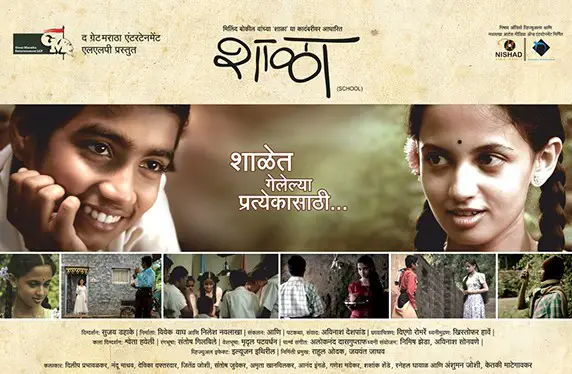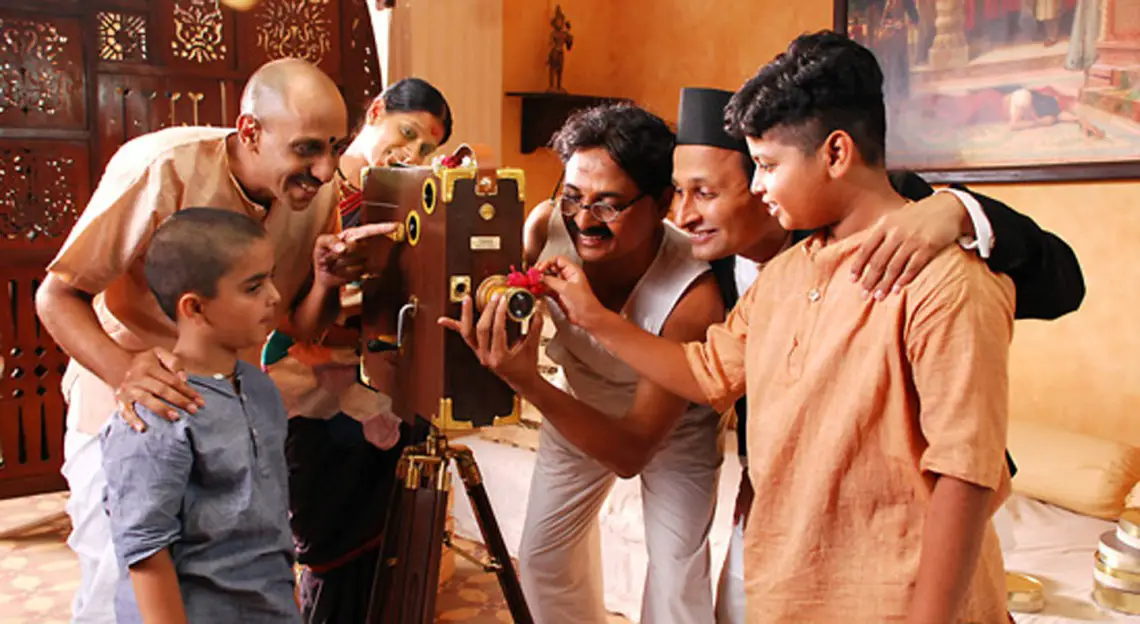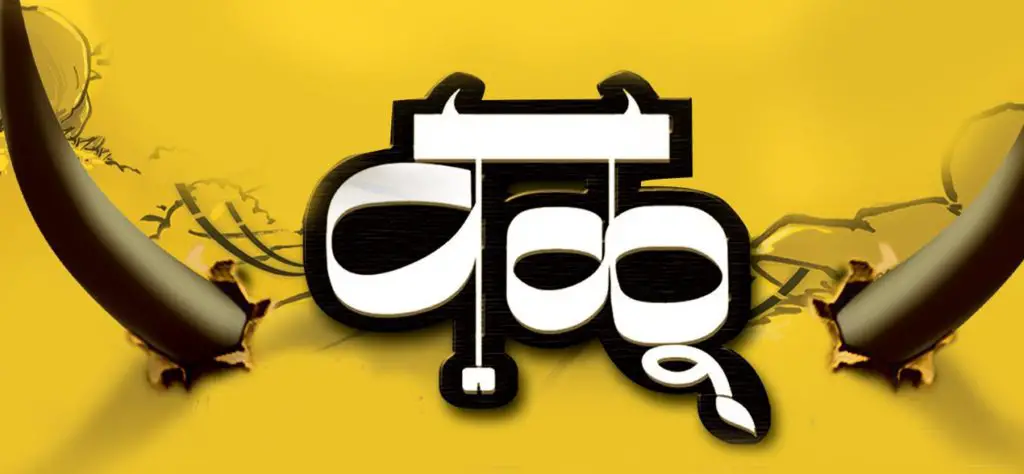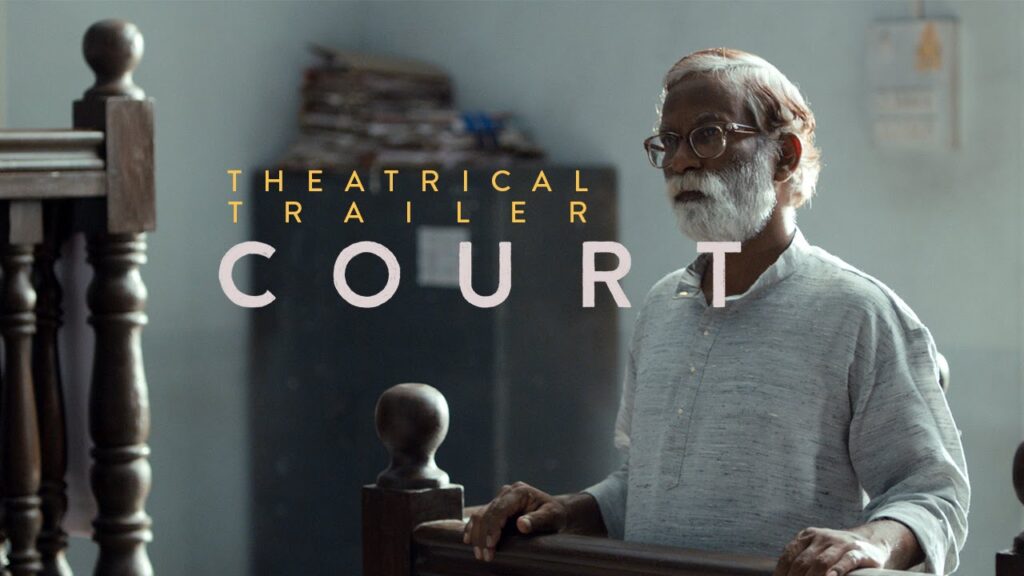Shwaas (2004) was a landmark film in the history of Marathi cinema. It became the first Marathi film in 50 years to have won a National Award, after Shyamchi Aai. Shwaas was also India’s official entry to the Oscars in the foreign film category that year. Three of the past 10-12 Indian films submitted to Oscars were Marathi and several Marathi actors, directors and composers have won national acclaim. Today, the industry is a force to reckon with. Unlike Bollywood, Marathi cinema places meaning over money and is leaps ahead in terms of content.
Their rich, content-driven films, rooted in the Marathi culture, lend it a universal appeal. Here’s a look at the gems and geniuses behind the renaissance of Marathi cinema and the progressive aspects of these films.
1. Deool (2011)
Director: Umesh Kulkarni

Deool is a story of a village simpleton (Keshya) who, as an effect of a heat stroke, hallucinates Dutta (God), atop a hill. The news soon spreads across the village. This culminates into a series of events where believers as well as non-believers take advantage of the situation, commercializing god and religion. From the newspaper guy to the village sarpanch, everyone recognizes a business opportunity in it. The village becomes a famous center of a large temple.
How a small, insignificant incident snowballs into a series of events blown out of proportion, is so masterfully executed. It all becomes so ridiculous in the end that Dutta (God) becomes a mere spectator, trapped in his own temple.
This film, so subtly, dealt with a rampant social issue. Writer and director Girish and Umesh Kulkarni received several angry calls from right wing political pawns for its bold depiction of rural politics with god and godmen.
Deool came way before Bollywood’s similar satirical takes on commercialization of religion — Oh My God, PK.
Exceptional performances from the cast — Nana Patekar, Mohan Agashe, Sonali Kulkarni, Girish Kulkarni, Dilip Prabhavalkar, Usha Nadkarni make it worth a watch. Umesh Kulkarni is in complete control as the pace never drops and the music lends a perfect rustic feel.
Best Moment: A guy from a neighboring village talking on the phone carves random markings on a tree trunk with a key. Co-incidentally, this happens on the hill Kesha claims to have seen Dutta. Four guys deduce, from the random markings, that it’s a picture of Dutta (god). It’s a hilarious scene and the ridiculous notion of finding God and enlightenment is dealt in a subtle, witty way.
Watch Deool on Amazon Prime
2. Shala (2011)
Director: Sujay Dahake

Several Marathi and Bollywood filmmakers have tried their hand at school-themed films. Their treatment is either amateurish or flat out rehashes of High School Musical (I am looking at you, Karan Johar!)
Shala is a rare film in the genre, that takes school life seriously. Its protagonists are regular middle class school children who are grappling with the all-important board year. School-time romance never seems escapist. We’ve all been through it and felt it. School trips, first pangs of love, hangouts, classrooms pranks. Shala makes you relive it all through a realistic depiction. A hush-hush professor-student romance. Bet you’d remember at least one from school, possibly with only half knowledge of what really transpired.
It’s these doubts about the characters’ actions and intentions that make this film beautiful. We see the school world from a kid’s perspective. A lot is hidden and protected from a Class 10 student, who feels frustrated because he thinks he is ready to be an adult at that age. Admit it, we’ve all been there.
It’s one of the most fabulously cinematographed Marathi films I’ve seen. All the child actors bring earnestness and natural naivety to their parts, while the adults are perfect representations of our parents, teachers and relatives.
It has a Kubrickesque feel to it in the sense that it explores the duality of life. The cool Mama (uncle), for instance, who promises he’d find an American girlfriend in the first half, turns up married to a regular Marathi girl, as per his father’s wish, in the second half. It’s this contradiction and realism that elevates the film from a run-of-the-mill school drama. It’s kind of depressing but reminds you of the good old, beautiful days. No escapism here.
Best Moment: Our protagonist’s best friend, who’s failed a class several times, proposes to a girl, right outside the school. It’s a bittersweet scene where we kind of root for the friend but realize how ridiculously foolish these kids are. It’s funny but sweet how they manage to gather the courage to propose the girl.
3. Harishchandrachi Factory (2009)
Director: Paresh Mokashi

From a movie that took school life seriously we turn to a film that takes a serious event and turns it on its head to deliver tender laughs. This film captures the journey of the making of the first Indian film (by Dadasaheb Phalke) in the early 20th century.
Dadasaheb Phalke is an eccentric but highly enterprising Marathi gentleman who falls in love with the art of movie-making when he first sees moving pictures. In British-ruled India where poverty was rampant, Dadasaheb, with meager wage, ventures with a dream to create an Indian film Raja Harishchandra.
The ridiculousness of the dream of a common Indian man is dealt with equal lack of seriousness. Absurd supporting characters abound, it deals with themes like superstition, societal pressure, inequality, regressive mindset about women in a way that never feels like a moral science lecture. The 1913 India is portrayed as it was — regressive, naïve, poor but human nonetheless. The film asks you to accept that the people associated with Raja Harishchandra were a bunch of imbeciles but that is how they needed to be to pull off such a mighty feat.
The art and cinematography is commendable, given that it pulled off the period aspect on a shoestring budget. We constantly feel and root for our protagonist, who tries to get a camera from Britain and ventures to go there by selling all the household items and nearly goes broke. He tries to coax and convince his wife to act in the film which she flatly refuses. Eventually men played women’s part in the film. But the makers don’t shove the enormity of all these situations in the audience’s face. You enjoy the journey of making Raja Harishchandra.
I wish I could claim a Marathi film was the first ever Indian film. Alas, it was a silent film. But I take solace in the fact that it was a Marathi who made the first Indian film (Raja Harishchandra (1913)).
Best moment: Dadasaheb Phalke’s friends drug him inconspicuously and take him to the hospital when he almost loses his eyesight obsessively studying the film material in darkness. It’s a hilarious scene since Phalke’s wife part takes in the conspiracy.
4. Natarang (2010)
Director: Ravi Jadhav
Every artist at some point in life has to let go of ego to make great art. But can an artist sacrifice every last smidgen of self respect in a patriarchic society for the sake of art? Ravi Jadhav’s debut film examines a passionate Tamasha (a popular Marathi folk art) artist’s classic struggle to strive for excellence v/s self demolition.
Atul Kulkarni loses himself in the role as Guna, a strong well-built poet who transforms into a Nachya (a “pansy” character, a man who acts in an effeminate manner) owing to his obsession with Tamasha. Atul Kulkarni takes it to a whole new level as his manliness is dismantled slowly and completely by Pandoba, played by the brilliant Kishor Kadam.
Guna dressed as Nachya sings the following lines on stage performing a Tamasha:
नकोस फोडु कान्हा माझी घागर आज रिकामी
हसेल सारी गोकुळ नगरी होईल रं बदनामी
आज दिली बघ नंदकिशोरा हाती लाज तुझ्या रे
रितीच घागर नशीबी माझ्या, शरण तुला मी आले
देवा शरण तुला मी आले
Translation:
Don’t break my pot Kanha, it is empty.
Whole Gokul will laugh at me, I will be shamed.
Today I have given my self-respect in your hands.
Empty pot is in my fate, I am taking refuge under you.
I am taking refuge under you.
On the face of it, it’s just a plea by Radha to Lord Krishna. Underneath, though, it has a huge subtext. Guna in a gender reversed role is giving up all self-respect to the lord of art and asking to be accepted even though the society ridicules him.
These lines encompass Guna’s pain and loneliness as even his family doesn’t understand his sacrifice for the sake of art.
Natarang’s music is as much the hero here as Atul Kulkarni. Ajay-Atul and Guru Thakur (lyricist) provide a genius score with tracks like Apsara Aali, Wajle ki Bara and Khel Mandala all of which became chart busters, placing the composers in the league of legends.
This film is Ajay Atul unleashed as they seamlessly tackle folk art while keeping their own artistic sensibilities intact. The music and choreography were the primary reasons Natarang was a huge commercial success.
Best moment: On Pandoba’s insistence, Guna dressed as Nachya, seduces a local minister. It is a highly repulsive moment in the film. The exploitation of Guna’s love for art by the people surrounding him gives you a visceral disgust. It is another brilliant moment of subtext where the audience knows that a lot more is happening than just seduction.
5. Balgandharva (2011)
Director: Ravi Jadhav
From Natarang we move to another film of male stage actors dressed as women but in completely different circumstances.
Bal Gandharva (Bal=child + Gandharva= Singer of heaven) was an iconic stage singer/actor who ruled the hearts of audiences and still continues to be a legendary figure.
Set in the early 20th century Maharashtra, where women were not allowed to work on stage, actors dressed in sarees was an accepted norm. The central conflict shifts from male ego to the limits to which art needs to be pushed in service of the audience.
Throughout the film, Bal Gandharva who is as obsessed with his art as Guna in Natarang tries to enhance his audience’s experience beyond what is required. He goes broke, sometimes due to his colleague’s betrayal and sometimes due his own volition.
Bal Gandharva did not understand economics and that is precisely what made his art much ahead of its time. The luxury shalus and jewelry made him a fashion icon among women. The grand beautiful sets on stage he created were a delight to the audience but bankrupted his savings.
It’s the classic contradiction where an artist must sacrifice his present life to make his art immortal.
Is the thought of being remembered by posterity enough to let go of worldly pleasures? And what does the family of such an obsessed man go through?
In a wonderful moment, Bal Gandharava’s mother explains to his wife that all of us tried to enforce the rules of this world on the singer of heaven. These rules will never be understood by Bal.
I am not an expert in Sangeet Natak so I can’t really explain the beauty of the music. I fell in love with its gorgeous art and National award winner Nitin Chandrakant Desai’s set design. The art work coupled with Subodh Bhave’s superb acting brought Bal Gandharva to life.
Subodh Bhave beautifully carries the film and every emotion of Bal Gandharva’s life. From his early days as the most sought after artist, to the revered but inconsequential old man, Bhave doesn’t miss a beat.
It is a riveting performance which pays perfect homage to the greatest stage singer of all time.
Best moment: Despite everybody’s protests and pleas, Bal Gandharva insist on performing just moments after he hears of his baby daughter’s death. He immerses himself in the performance and pours emotions into the role even as his colleagues start crying on stage. Eventually he breaks down when he turns and sees himself dressed as a woman in the mirror. He remembers his wife who is left alone in her sorrow. It is a beautiful moment where we see that even his love for art is not impervious to the grief of losing family.
6. Aga Bai Arrecha (2004)
Director: Kedar Shinde
The cinema snob in me says this is by no definition the greatest Marathi film. But the child in me loves this film. And you can clearly see who won the conflict. Loosely based on Hollywood film What Women Want, Aga Bai Arrecha is adapted to Marathi sensibilities and we can relate to the middle class household.
Sanjay Narvekar plays the perfect responsible Marathi man irritated by the opposite sex. It’s a hard life to be the sole breadwinner of a middle class house and Sanjay perfectly blends emotional vulnerability with helplessness. One day, God gives him the power to understand women. He can hear every single thought of every woman he ever encounters.
While the concept is not really original, the treatment certainly is. The film is a light-hearted take on women’s issues, but never goes the full feminist mode. Our protagonist understands that man is not the only victim here. Economic stress, divorces, daily traffic, annoying customers and introversion are issues that affect women equally.
In a beautiful song sequence with the lyrics of Durga aarti, Shriranga treats all women with dignity and tries to make their life better with even little things. He helps an old lady cross the road, a couple of little girls make a sand castle, and talks with his mute grandmother since he can now exactly understand her thoughts. All these acts of kindness give him a sense of calm and internal satisfaction. The beautiful thought is conveyed in the simplest language of great visuals and amazing music.
But Aga Bai Arrecha never falls in the trap of ignoring men completely. It is as much a dissection of the male psyche as it is of understanding women.
Dilip Prabhavalkar’s unsaid words go a long way in telling the tragic story of a man affected by the 1980’s textile mill workers strike.
The director seems to have had great fun making it and that translates into an endearing film.
Best moment: Shriranga (Sanjay Narvekar) comes home after a bad day at work. Every time he tries to take a bite of the food, the women in the house bombard him with issues and complaints. The scene starts out funny as Shriranga doesn’t get a chance to speak or eat, and quickly snaps. A middle class man’s frustrations couldn’t have been better conveyed.
7. Court (2014)
Director: Chaitanya Tamhane
Judiciary system in real life is about 1 percent histrionics and 99 percent colossal boredom. Most films take this 1 percent and exaggerate it for cinematic effect. Court (2015) is a rare film that way. It shows that oft ignored side and reflects it from a mirror that highlights the hypocrisies of our legal system.
In one scene, a human rights lawyer is presenting some of the latest examples of court prejudices against activists. Two guys come on stage out of the blue with a rotating table fan and start installing it. The fan turns on and drowns the voice of the lawyer who is about to say something substantial.
It is such absurdities presented in a way devoid of even the slightest theatrics that makes Court so special. It is a Kafkaesque representation of Indian courts where dates are changed because lawyers need to attend family functions. Where hearings are adjourned because the witness has a sleeveless shirt on. And where a poem forms the basis of a completely unconnected ‘suicide’ of a gutter cleaner.
There is no escape.
The movie is more about the people associated with the court than the court itself. The people who understand facts and logic have long given up while the opposite kinds are hopeless to the point of exhaustion.
(They evoke the helplessness you feel watching a debate with Pahlaj Nihalani. You know there is no way to reason with such people, yet you marvel at the sheer idiocy on display).
The movie instills a fear in you without attempting to even startle you. The director understands that there is no need for any background score when just the day-to-day proceedings in the session’s court are scary enough.
Truth is stranger than fiction and Court presents the naked truth like no film you’ve ever seen before.
Best Moment: The sessions’ court judge discusses with his relative who has an autistic child. The judge advices that consulting a numerologist or using a gemstone ring would serve better benefits than a therapist/psychiatrist. It’s a moment that shocks our core when we realize our courts rely on the judgments and wisdom of such men.
8. Valu (2008)
Director: Umesh Kulkarni

The world of absurdities continues but now we move from court to a village. This is a story about a village and a forest officer’s efforts to catch a mad wild bull. Except that it is not. The bull is just the representation of the villagers’ joblessness and internal politics.
The wild bull is a fantasy concocted by villagers in order to make the village a tad bit interesting. The beauty is the contradiction that the people are not lying. In fact, they are naively convinced that the bull is out there to harm them. Their behavior is what makes the bull harmful than misunderstood.
Girish and Umesh’s debut film propelled Marathi industry to new heights with its innovative storyline and unique rural setting. Marathi films never explored the funny side of rural politics. The makers accepted the rural idiosyncrasies and presented their flaws in an extremely humane manner.
The brilliant writing blends entertainment with poignant commentary on rural issues like lack of toilets, youth representation in politics, suppressed lovers and animal oppression.
The film takes a dig at the society where everyone is attention hungry. The forest officer’s brother who is out there to make a documentary about catching bull is instead made to film everything from children’s dances to a dejected lover’s story.
Subtle and witty jokes fly from all sides. I find something new to laugh at every time I watch Valu. The ensemble cast is in top form and brings a chuckle in seemingly ordinary moments. A fine example is Bharti Achrekar’s expressions when her husband, the sarpanch, narrates a story of how the village’s donkeys were part of the Panipat battle.
Girish, Umesh introduced a brand of intelligent, understated cinema that was lacking in Marathi industry for a long time.
Best Moment: The forest officer and 10-12 villagers are hiding around the trap set to catch the wild bull. When the officer calls the unsuccessful vigil off, only a couple of villagers turn up. The rest, apparently, left their hiding spots for lunch. It’s a piece of random humor where villagers find lunch more important than catching a mad bull.
9. Rege (2014)
Director: Abhijit Panse

Inspired by RGV’s crime classics, Rege builds a gripping atmosphere of underworld and corrupt cops where money is the only loyalty.
Without giving away much, Rege is a cat-and-mouse chase between cops and criminals except it’s all for money. Law and order is the last priority.
Director Abhijit Panse seamlessly tackles the tricky putting together of past, present and future events. All of it is a jigsaw puzzle that fits perfectly only at the end. Seemingly innocuous scenes are important to the narrative and emphasize the fact that crime world is darker than we’d imagine.
The cinematography is the real winner as it creates a claustrophobic effect with close lens shots. The shadows and dark lighting are perfect metaphors to the grey areas of police investigations. The hand held camera movements underline the murky dealings our protagonist Rege. He is a medical student who finds himself caught in it due to his fascination with criminals.
I particularly enjoyed the good cop bad cop routines of Mahesh Manjrekar and Pushkar Stotri as they get information out of Rege. Dark humor is abundant as the narrative shocks you with manipulation techniques cops use for confessions.
Rege is an uncomfortable but thrilling experience. It’s a brave film that deserved more appreciation.
Best Moment: A constable thrashes a random criminal in the background. An officer is on the phone with his wife as he tries to subdue her requests for dinner, amid screams of the beatings. It’s a brilliant moment about the matter-of-fact nature of police job which reminded me of a similar scene from Anurag Kashyap’s Black Friday.




